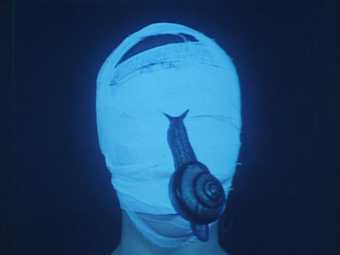āTo me, a bandaged adolescent or a snail crossing the screen transversely can both be viewed as a kind of dermatitisā
Shūji Terayama, 1975
Ā Terayama perceived a kindred sensibility in French playwright Antonin Artaudās dark images of pestilence and plague, visualising the defiled body in A Tale of Smallpox as a challenge to a dominant culture of social harmony, consensus and avoidance of discord. The smallpox virus has created its own unique atmosphere in Terayamaās film where the skin of a bandaged adolescent and the surface of the filmic image are subjected to a bizarre ādisturbanceā as snails cross the screen and nails are hammered into the skull of the ailing patient. Illness in this film is as much a psychic entity as a physical one and manifests itself in an array of theatrical tableaux from grotesque women rigorously brushing their teeth to a snooker game where the players in white face makeup behave like automata. A Tale of Smallpox uses a medical theme to chart the traumatic dream life of Terayamaās times, evincing deep-rooted concerns in the Japanese national psyche that hark back to the upheaval of Meiji modernisation and the devastation of World War Two. In The Erazer, the commentary on recent history is even more direct with the inclusion of torn and sewn together photographs showing vanished parents and soldiers. The āMother of the Northā is the protagonist of this film and she obsessively eliminates images of a pristinely clad naval officer against the background of a lonesome Pacific shoreline.
Ā Terayama lampooned nostalgia and traditionalism and approaches both themes in these works with a mixture of love and loathing. As a sick man who succumbed to nephritis during his university years Terayama regarded himself as an eternal outsider and used his lifelong illness and periods of hospitalization to renegotiate his relationship with mainstream society. He started by holding literary salons in his hospital room and eventually surrounded himself with a band of itinerant performers, musicians and artists who would form the nucleus of his TenjÅ Sajikitheatre group.
Ā Terayamaās work with TenjÅ Sajiki celebrated the grotesque and fictionalised identity in the wake of a post war void of memory. This was a dramaturgical revolt against conservatism that permeated the forms of Terayamaās cinematic work.
The Erazer (Keshigomu)
Shūji Terayama, 1977 Japan, 16mm, 20 min
A Tale of Smallpox (HÅsÅ-tan)
Shūji Terayama, 1975 Japan, 16mm, 31 min
Followed by a free Shūji Terayama film performance in the Turbine Hall at 21.00
Curated by Thomas Dylan Eaton in association with É«æŲ“«Ć½.Ā
With generous support from Daiwa Anglo-Japanese Foundation, Japan Foundation, Sasakawa Foundation, Toshiba Foundation, and All Nippon Airways.Ā
Tate Film is supported by Maja Hoffmann / LUMA Foundation.

